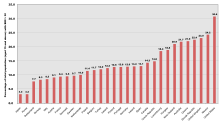Health in New Zealand
This article's lead section may be too short to adequately summarize the key points. (November 2018) |
New Zealand is a high income country, and this is reflected in the overall good health status of the population. However like other wealthy countries, New Zealand suffers from high rates of obesity and heart disease.[1]
History[]
Māori life expectancy was about 30 years in the 18th century, similar to that of Western Europe. After Europeans brought new diseases, and loss of land impoverished many Māori, the childhood mortality rate was very high and Māori life expectancy dropped to 25 years for men and 23 years for women by the end of the 19th century.[2]
Pre-contact Māori viewed disease as a punishment for breaking tribal tapu but also recognised that some families were prone to certain disease. The standard practice of tohunga was to isolate the victim in a small shelter. The most common serious disease was tuberculosis (kohi). However, Māori did not recognise the symptoms as being from one disease. Kohi was considered the work of demons and caused by makutu (witchcraft).[3]
Public health programs[]
There are public health campaigns for obesity, drinking, smoking and various vaccines.
Health care[]
The health care system has undergone significant changes throughout the past several decades. From an essentially fully public system based on the Social Security Act 1938, reforms have introduced market and health insurance elements primarily since the 1980s, creating a mixed public-private system for delivering healthcare. In 2012, New Zealand spent 8.7% of GDP on health care, or US$3,929 per capita. Of that, approximately 77% was government expenditure.[4] In a 2010 study, New Zealand was shown to have the lowest level of medication use in 14 developed countries (i.e. used least medicines overall), and also spent the lowest amount on healthcare amongst the same list of countries, with US$2510 ($3460) per capita, compared to the United States at US$7290.[5]
Mental health[]
Mental health in New Zealand generally follows the trends of mental health in other OECD countries.[6] New Zealand's outdoor life style and high standard of living are balanced by isolation and a self-reliant culture, which discourages asking for help.[7] Historically, people with mental health problems were institutionalised, whereas now the focus is on care in the wider community.[6] The stigma around poor mental health has been lessened in recent years as a result of this change and public education campaigns. However, New Zealand's Māori people, other minorities, and youth continue to be over-represented in the negative mental health statistics.[6][8]
Health statistics[]

The following statistics are a sample from the World Health Organization Statistical Information System. The year on which the data were sampled follows the statistic in brackets.
- Demographics
- Population (in thousands): 4,460 (2012)
- Total fertility rate (per woman): 2.07 (2012)
- Adolescent fertility rate (%): 27 (2004)
- Funding
- Per capita government spending (PPP Int $): 1,905 (2006)
- Per capita total spending (PPP Int $): 2,447 (2006)
- Total expenditure (% of GDP): 9.4 (2006)
- Life expectancy
- Life expectancy at birth (years): 82 (2012)
- Life expectancy for females (years): 84 (2012)
- Life expectancy for males (years): 80 (2012)
- Neonatal mortality (per 1,000 live births): 3 (2012)
- Infant mortality (per 1,000 live births): 5 (2012)
- Years of life lost to communicable diseases (%): 5 (2002)
- Years of life lost to injuries (%): 17 (2002)
- Years of life lost to non-communicable diseases (%): 79 (2002)
Life expectancy is lower for the Māori and Pacific populations by around six years.[9]
See also[]
- Health in Australia
- HIV/AIDS in New Zealand
- COVID-19 pandemic in New Zealand
- Road toll (Australia and New Zealand)
References[]
- ^ Streib, Lauren (8 February 2007). "World's Fattest Countries". Forbes. Retrieved 12 February 2009.
- ^ Pool, Ian (14 March 2019). "Death rates and life expectancy". Te Ara – the Encyclopedia of New Zealand. Retrieved 5 October 2019.
- ^ Buck, Peter (1910). "Tuberculosis". Medicine Amongst the Maoris, in Ancient and Modern Times. pp. 72–73. Retrieved 11 April 2017.
- ^ "WHO Statistical Information System". World Health Organization. Retrieved 6 March 2020.
- ^ Johnston, Martin (30 July 2010). "NZ ranks last in medicine use and lowest health spender". The New Zealand Herald. Retrieved 6 March 2020.
- ^ a b c Brunton, Warwick (21 June 2018). "Mental health services – Te Ara Encyclopedia of New Zealand". Ministry for Culture and Heritage. Retrieved 6 March 2020.
- ^ Illmer, Andreas (15 June 2017). "New Zealand's shocking youth suicides". BBC News. Retrieved 6 March 2020.
- ^ McAllen, Jess (27 October 2018). "History repeating – New Zealand's mental health inquiries". Radio New Zealand. Retrieved 6 March 2020.
- ^ "New Zealand's health service performs well, but inequities remain high". The Conversation. 20 September 2017. Retrieved 22 November 2018.
- Health in New Zealand